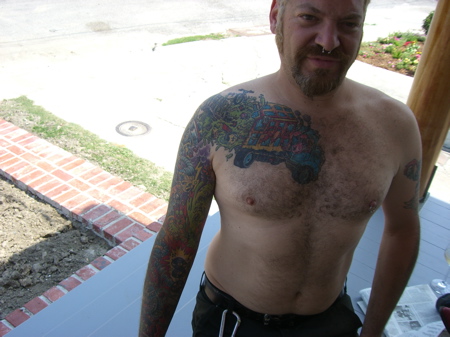Ink Stains from Katrina – Chapter 2 – Charles
Charles and the Garbage Truck route

Charles Handler
Industrial Organizational Psychologist
Charles’ tattoo was not completely Katrina related although he said the event did bind together a lot of themes into one piece of artwork that now spans half of his chest and covers his entire arm like a sleeve. “The decision to cover my whole arm was a big decision and I knew the image should not be arbitrary,” he said. The tattoo is a watershed depiction of the harshness of New Orleans post-K. It is a negative theme of the destruction of all things important, softened by the appearance of cute fuzzy animals.
The starting point is a garbage truck with New Orleans’ area code 504 written on it. “What did I see when I got back? Garbage. Slime oozing. There were things you normally see and things not normal. How does my wife, Anne, want to be depicted? As a horse? A horse on a surfboard? Cars are represented. There is a robotic pit-bull totem I invented a long time ago. There’s vintage musical images. The storm had a big impact on music. A New Orleans water meter ends the image – sort of an ashes-to-ashes as you cycle down the sewer,” he said.
“What clouds my mind is the ruination, the disgusting muck, but that’s not going to be my state of mind forever,” he said. The muck is depicted by green slime that fills in all the dead space of the tattoo.
The decision to undertake such a detailed tattoo was directly related to Charles’ Katrina experience, which he said taught him to not be afraid to “express who I am.” The tattoo took many sittings to accomplish and a lot of pain to endure. “It taught me patience. This isn’t the type of thing you can do at once.” Every two weeks, Charles would go for a sitting and then his body would have to take a break to heal. “It’s tough on your body,” he said. “Your body can have a reaction to the ink; it traumatizes.”
Many people describe their Katrina tattoos as a rite of passage. Charles described it as a willingness to accept “who I am and cultivate the part of me that I pushed under for so long. The creative side of me that says I don’t care what others think.” More importantly, he said, “The tattoo places me in a different category of people. It helps me be me. Even the act of doing it, enduring pain and being patient, which is not manifested in the artwork, was part of the experience for me. The willingness to put myself out there was, in the end, cathartic.”
“The beauty of living in New Orleans is that people don’t judge you by the way you look.”